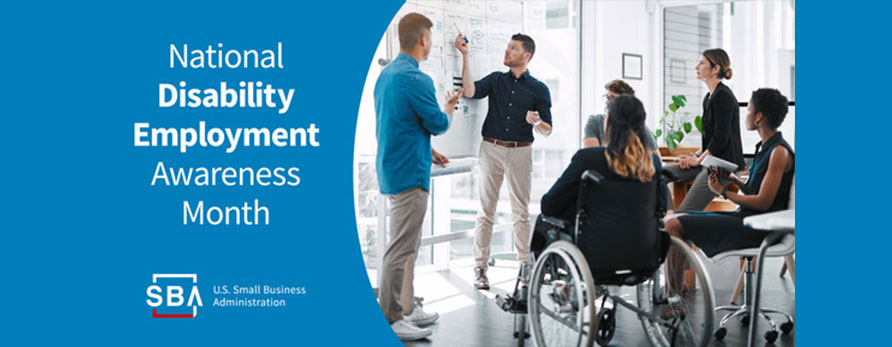How to Create an Inclusive Hiring and Workplace Culture at Your Small Business
Guest Blog: Zina Sutch, U.S. Small Business Administration
This National Disability Employment Awareness Month, learn more about the benefits and steps of hiring individuals with disabilities at your small business.
Employees with disabilities bring immense value to their workplaces. Just ask Oowee Products – a leather manufacturer and Paycheck Protection Program (PPP) loan recipient. The Asheville, North Carolina-based business, which makes handcrafted beverage accessories, works with the Autism Society of North Carolina to provide jobs to people with autism. Through economic modeling, research conducted by Accenture, the American Association of People with Disabilities (AAPD) “found a strong correlation between financial performance and well-developed disability-inclusion practices.”
Inclusive work environments like Oowee Products provide all qualified employees – including those with disabilities – the flexibility they need to shine. These workplaces embrace the differences that make each employee unique and exceptional. In doing so, they benefit from increased employee satisfaction and productivity. Small business owners can take the following steps to make their workplace more inclusive.
Develop an Inclusive Hiring Process
The first step to establishing an inclusive hiring process is to write a job description that outlines the specific accommodations that you’re willing to provide to help workers successfully perform their job. During the recruitment process, you should ensure that individuals with disabilities can take part in the process effectively. This may require you to provide accommodations, such as adjustments to a job, work environment, or interview process. According to the Harvard Business Review, it may be surprising, but most accommodations cost nothing and when a cost is involved, it is usually less than $500.
You can also tap relevant organizations to find qualified hires with disabilities. You can find a comprehensive list of organizations on our website, but here are a few initial ideas:
- Local Workforce Development Boards (WDBs): WDBs connect companies to the resources they need to strengthen their business and their workforce, including skilled employees with disabilities.
- American Job Centers: American Job Centers help with recruiting, hiring or training employees, including people with disabilities who are ready and willing to work.
- Employer Assistance and Resource Network on Disability Inclusion (EARN): EARN offers a list of online job posting boards that can help small businesses find qualified workers with disabilities.
Once you have an interview on the books, be sure to read this U.S. Equal Employment Opportunity Commission guide to make sure you are following all necessary guidelines for interviewing employees with disabilities. For example, there are certain questions you cannot ask job applicants regarding their disabilities or medical conditions.
Changing the standard interviewing process and assessment practices that tap into the skill sets you are seeking can also overcome some of the barriers that people with disabilities may experience in the interview process. A small business can be more confident in their ability to find strong candidates and make quality selections when using a variety of assessments that may better reflect the candidates strengths.
Create a Culture of Inclusivity
Beyond establishing an inclusive hiring process, it is also important to foster an everyday workplace culture of inclusivity. This may entail offering accommodations (e.g., screen reading software, raised desks, flexible work schedules, etc.) to employees who need them.
Businesses can take advantage of financial incentives to make reasonable accommodations, such as the following federal tax incentives:
- The Work Opportunity Tax Credit, available for hiring individuals from certain groups who have consistently faced significant barriers to employment.
- The Barrier Removal Deduction, which allows businesses to deduct up to $15,000 for making a facility or public transportation vehicle more accessible.
- The Disabled Access Credit, a non-refundable credit for small businesses that incur expenditures for the purpose of providing access to persons with disabilities.
Consider providing all employees, especially those in supervisory roles, training on creating inclusive cultures, understanding challenges that colleagues may be facing, and the types of accommodations that are available. Increasing awareness and knowledge helps reduce the stigma that is often associated with having a disability, which assists in making everyone feel like they belong.
By investing in recruiting, hiring, and retaining talent – including people with disabilities – you can make your business more productive, and create a more satisfying work experience for your employees. For more hiring help, connect with a local SBA resource partner.


